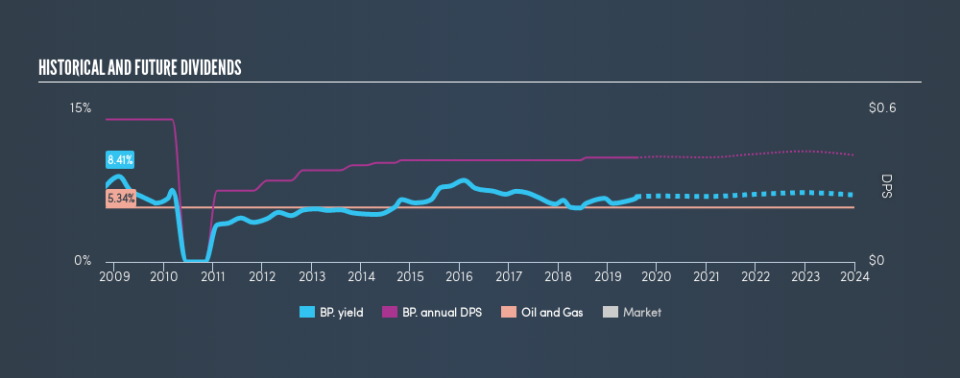Why You Should Leave BP p.l.c. (LON:BP.)'s Upcoming Dividend On The Shelf

BP p.l.c. (LON:BP.) is about to trade ex-dividend in the next 3 days. This means that investors who purchase shares on or after the 8th of August will not receive the dividend, which will be paid on the 20th of September.
BP's next dividend payment will be US$0.10 per share, and in the last 12 months, the company paid a total of US$0.41 per share. Calculating the last year's worth of payments shows that BP has a trailing yield of 6.4% on the current share price of £5.269. If you buy this business for its dividend, you should have an idea of whether BP's dividend is reliable and sustainable. So we need to investigate whether BP can afford its dividend, and if the dividend could grow.
View our latest analysis for BP
Dividends are usually paid out of company profits, so if a company pays out more than it earned then its dividend is usually at greater risk of being cut. Last year, BP paid out 93% of its income as dividends, which is above a level that we're comfortable with, especially if the company needs to reinvest in its business. Yet cash flows are even more important than profits for assessing a dividend, so we need to see if the company generated enough cash to pay its distribution. Over the last year, it paid out more than three-quarters (81%) of its free cash flow generated, which is fairly high and may be starting to limit reinvestment in the business.
It's good to see that while BP's dividends were not well covered by profits, at least they are affordable from a cash perspective. Still, if the company continues paying out such a high percentage of its profits, the dividend could be at risk if business turns sour.
Click here to see the company's payout ratio, plus analyst estimates of its future dividends.
Have Earnings And Dividends Been Growing?
When earnings decline, dividend companies become much harder to analyse and own safely. If earnings decline and the company is forced to cut its dividend, investors could watch the value of their investment go up in smoke. Readers will understand then, why we're concerned to see BP's earnings per share have dropped 19% a year over the past five years. When earnings per share fall, the maximum amount of dividends that can be paid also falls.
The main way most investors will assess a company's dividend prospects is by checking the historical rate of dividend growth. BP has seen its dividend decline 3.1% per annum on average over the past 10 years, which is not great to see. While it's not great that earnings and dividends per share have fallen in recent years, we're encouraged by the fact that management has trimmed the dividend rather than risk over-committing the company in a risky attempt to maintain yields to shareholders.
To Sum It Up
From a dividend perspective, should investors buy or avoid BP? Earnings per share have been shrinking in recent times. What's more, BP is paying out a majority of its earnings and over half its free cash flow. It's hard to say if the business has the financial resources and time to turn things around without cutting the dividend. Overall it doesn't look like the most suitable dividend stock for a long-term buy and hold investor.
Wondering what the future holds for BP? See what the 21 analysts we track are forecasting, with this visualisation of its historical and future estimated earnings and cash flow
We wouldn't recommend just buying the first dividend stock you see, though. Here's a list of interesting dividend stocks with a greater than 2% yield and an upcoming dividend.
We aim to bring you long-term focused research analysis driven by fundamental data. Note that our analysis may not factor in the latest price-sensitive company announcements or qualitative material.
If you spot an error that warrants correction, please contact the editor at editorial-team@simplywallst.com. This article by Simply Wall St is general in nature. It does not constitute a recommendation to buy or sell any stock, and does not take account of your objectives, or your financial situation. Simply Wall St has no position in the stocks mentioned. Thank you for reading.

 Yahoo Finance
Yahoo Finance 
